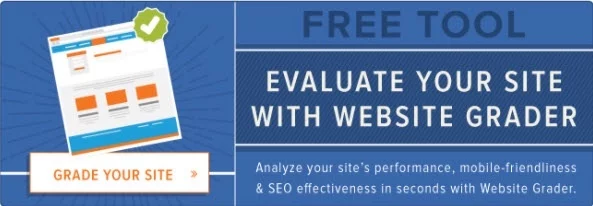Attribution Reporting Fundamentals
- Home
- Attribution Reporting Fundamentals
We’re going to be covering a topic that is really fascinating and incredibly relevant for anybody who’s using the HubSpot platform – anybody who's doing digital marketing. We're talking about attribution reporting. It's one of the main reasons why people go to a system like HubSpot and specifically to HubSpot itself now, and it's a feature of the enterprise onboarding software.
We're going to talk about attribution reporting fundamentals. You'll learn the basics, you learn how to do it in HubSpot and for folks who have done it a lot before, I hope that you'll still come away with something new to apply that maybe you didn't know before.
What is Attribution Reporting?
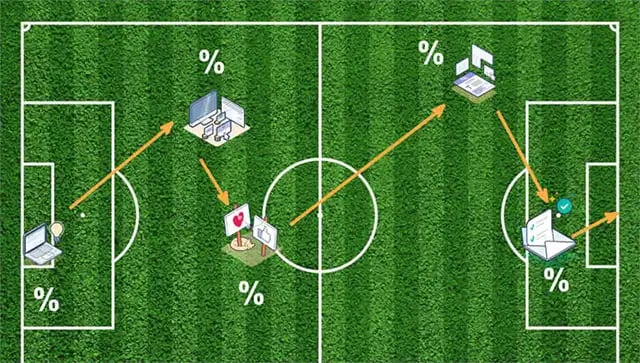
When I think of attribution reporting, there's only one thing that comes to mind, which is football. Let's imagine a football play. Let's say that the ball starts with the goalie, the goalie tosses it up to the defender, kicks it into the midfielder up to the forward who lofts in that perfect cross, and then the striker heads the ball home. The question then is: who deserves the credit for that goal?
There are several ways that we could look at that. The traditional way is to give all the credit to the goal scorer. That's the Ronaldo. That's the Messi. That's the Wayne Rooneys of the world, right? The question we ask there is who scored the most goals? That's the metric we see in the newspaper. That's the metric we see in the program when we go to the stadium – who scored the most goals?
But that's not the only way to look at it. Another traditional way to look at it is to give 100% of the credit for that goal to the forward – the man or woman who lofted up the cross that got headed into the net because, without that cross, the goal would've never been scored.
So we call that metric, “assists”. We have goals, we have assists. There's no better or worse metric to measure – they’re just different. It depends on what you're optimising for. Different players, in this case, have different roles on different parts of the field. So who are the most assists?
There are any number of ways we can measure this; goals and assists are the most traditional. We could give credit to any number of players all the way even back to the goalie – without that first pass into the field, the goal would have never been scored.
We could give credit to any number of players on the field, it just depends on what we're trying to optimise for. The question here is: why even count? Why does this matter for the players? Why does this matter for the manager? Who even cares? Why count these metrics?
For the players, it's all about recognition. So if the players count goals – if we count assists – then the players can demand bigger contracts, more playing time or more endorsements. It's all about recognition – but understanding what role they play so that they can have more recognition from fans and the team.
For the manager, it's about optimisation. If you know that Steve Gerard and Wayne Rooney are upfront and they score the most goals and get the most assists, you can put those players in the right place at the right time to score even more goals in the future. And then for both of them, it's about leverage.
So if you're counting goals and assists, it'll give you more leverage to ask ownership for more money. That gives you more leverage to ask the community for a new stadium, etc. It's all about leverage for both of those; it's a seat at the table with leadership.
You can imagine where we’re going with this: we can apply that same idea – that same concept of credit and attribution – to customer journeys. If we only give credit to the goal scorer – that's the Wayne Rooneys of the world, the thing that happens right before the conversion happens, in this case – we're only going to give credit to the sales team. And so for us as marketers, we miss out on a whole big part of the story – everything that happens before the sale gets made.
So same question here: if we can identify those metrics, the goals, the assists and all the other attribution, why does that matter for marketers like me? And then why does that matter for marketing leaders? Well, you guessed it: it's the same as the football analogy.
For the marketer, it's about recognition. If I, as a marketer, can prove which individual touch points I created along the way that contributed to revenue, I can ask for a raise. I can ask for more responsibility. I can ask for more headcount on my team. It's all about recognition.
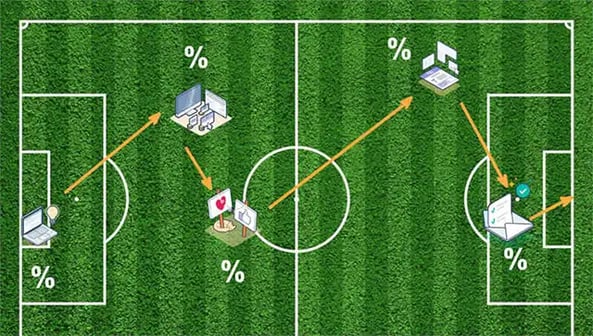
For the marketing leader, it's about optimisation. So if we know that certain sources or certain assets are doing the most work to drive revenue – to drive goals being scored – we can put those pages in those channels in a position to succeed the next time around. And then for both, it's about leverage. So just like a football team wants leverage with ownership, they want leverage with the community.
We as marketers and as marketing teams want leverage with the sales team. We want leverage with leadership. We want budget, we want headcount and so on. If we tie what we do to dollars, then we get leverage.
That's all we can ask for.
So that's the concept of attribution. Attribution is all about giving credit where credit is due so that we can have leverage, we can optimize as managers and we can get credit as marketers for the work we do.
Attribution Reporting in Practice
Let’s walk you through a specific example with a real HubSpot customer called A3C. A3C is a music festival that's based in the United States – in Atlanta, Georgia. They have been a HubSpot customer for a while and have avid fans who come year after year. One of their newest fans that I want you to meet is named Bethany. I'm going to walk you through Bethany's journey with A3C from first interaction through becoming a loyal customer.
1. First Interaction: Bethany is from Atlanta, Georgia, and she wanted to find things to do around Atlanta in the fall, so she Googled things to do in Georgia in October. She ended up finding A3C’s website, went to A3C’s website, explored a little bit, just clicked there on the blog, and then left. So she Googled it – that's what we at HubSpot will call her first interaction.
- Lead Created: Next up, a week later she saw a Facebook ad on our Facebook feed about A3C. She clicked on the ads and perused the website again. She checked out the lineup a little bit. This time, she ended up subscribing to their blog and signed up for more information. That's the second key touchpoint. First interaction, second key touchpoint: signed up for the blog through an ad. We call that in HubSpot the moment that her lead in the system was created. So in the CRM, the lead was created via clicking an ad.
- Deal Created: The third key touchpoint: Bethany clicked a tweet. So a week later she just clicked a tweet on A3C’s feed. She explored a little bit. This time she found the line-up and found that you could sign up to get in line for tickets. Tickets weren’t on sale, but you can reserve your place in line to get tickets when they did go on sale. So she ended up doing that. That was a moment of purchase intent. She showed that she was interested in actually purchasing tickets. In HubSpot, A3C has HubSpot CRM and they create a deal in HubSpot. That's the third key moment at first interaction, that moment the lead gets created and then now because she reserved tickets, the deal gets created.
- Closed Won: Then finally, she signed up for notifications. She gets that email that tickets are on sale, she buys a ticket and that's when in HubSpot the deal goes to closed won. That deal gets closed. Total purchase: 800 bucks.
So, a recap of Bethany's situation: the first interaction was when she Googled it. Second interaction: she clicked an ad, ended up surfing the blog, filling out a form. Third interaction: clicked a tweet, ended up back on the site, reserved a spot in line.
Fourth interaction: bought the ticket by clicking an email. Four key interactions. That's the way that she saw it.
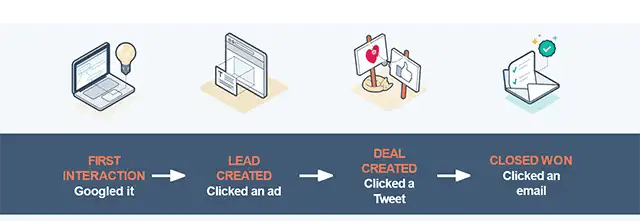
One way that we might look at it in HubSpot is through the source of those interactions. That first Google search, that first interaction, is what we call organic search: an organic search-sourced interaction. When that lead was created (clicked on an ad on Twitter (X)), is what we call a paid social ad. Third is organic social (she clicked on a tweet, and a deal was created), and then finally got that email and ended up going close to winning the deal through email.
The idea here is we have these four key interactions from Bethany. All we're doing, just like in the football play, is assigning percentages of credit for first, lead, deal created, and closed won and assigning dollar values to each of those interactions as well.
So the same way on the football field, we were giving assists to that second class or goal, just to that last final conversion before the goal was scored. It’s the same idea, and same concept here for the customer journey, from a marketing perspective.
Attribution Models
The way that we assign credit in football is through goals and assists; in marketing, we have attribution models. An attribution model is a way of giving credit to different touchpoints along the way. There are a dozen different ones of these.
You can do all of these that we see here and more inside of HubSpot or inside of Google Analytics or whatever other tool you might be using. The main point here is there are several different ways to do it. There's no best way to do it. So oftentimes the question is: do I do multi-touch? Do I do single touch?
Do I do first or last touch? The answer is: it depends. It's like asking: do I measure assists or do I measure goals on the football pitch? It just depends on what you want to optimise for.
- First Touch Model
- Last Touch Model
- Linear Model
- Full Path Model
- U-Model
- W-Model
Today, we’ll walk you through two specific examples of attribution models, and they start with the question that you want to ask or that you want to find an answer to. So whenever we're thinking about an attribution model, it doesn't start with a model. It starts with the question.
- First Interaction – Single Touch: gives all the credit to the first touchpoint someone has with your brand on the way to becoming a customer.

- The first question might be: how are paying customers first finding out about the brand? We want to get a sense of what's bringing business in the door for the first time and for that, we use what we call first interaction. The first interaction gives all the credit to the first touchpoint that somebody has with the brand on the way to becoming a customer.
We call that single touch because it's giving all of the credit to one single touch point. In football, that would be akin to giving all the credit to the goalie. It’s a different model, it's a different way than we traditionally look at it on the football pitch, but in marketing, it's a good and important one. - In Bethany's case, organic search was that first touch point. She Googled it. She ended up finding A3C's website. In that case, 100% of that credit – all 800 bucks in revenue – would go to organic search. I'll show you in just a second how to run this report inside of HubSpot, but what we end up with is pretty straightforward. I wanted to show you the final result first. Along the X axis, where we have the interaction source, direct traffic, email marketing, and so on.
On the Y axis, we have the amount of revenue from that source via that specific first interaction model that we're looking at. In this case we quickly just analyse those results we see for A3C: that first touch, the first thing that brought them new business into the website, tended to be direct traffic, email marketing, and paid search.
So direct traffic: somebody just came right to the website, and they typed in A3C into the search bar. That's probably through just brand recognition, folks hearing from their friends is coming to the site and buying tickets. But email marketing and paid search – there are some good takeaways there for the A3C marketing team.
They're sending emails that are getting people to the website for the first time and buying tickets for the first time and the same with paid search. If what they're trying to do is get new people to buy tickets, they should lean into email marketing and paid search. That's a really good takeaway I think for the A3C team.
- Another question we can ask is: but what about the whole rest of the journey?
- We as marketers impact every single piece of the journey. What else? For that, we might use what we call full path attribution. The full path splits 90% of the credit among those four big interactions that we saw with Bethany and then the other 10% goes to any other interaction that they have.
It focuses on those big key moments – 90% – and then all the rest is split. Because there's a bunch of different interactions that we're splitting credit between, we call that a multi-touch model. You might hear multi-touch revenue attribution thrown around; it’s a really big buzzword keyword in the space right now. All it means is that instead of just giving all the credit to the goal scorer or the assist, it’s splitting credit across many different players on the pitch at once. - In Bethany's case, we take 90% of the credit and we split it across that first interaction, which leads to creating a moment, the deal creates, and then the closed won.
Let's say, just in this example, that she did something in between. Maybe she looked at a blog post between when she signed up for that ticket notification and when she bought the ticket. We would give that 10%. So 22.5% is just if we take the 90%, cut it in four ways, we give 180 bucks to each of those four big moments.

- In this case, the report looks similar but we might have a different takeaway. So first we said email marketing and paid search were bringing people into the door. They were bringing new business into the door for the first time. In this case for A3C, paid social is great for this full path model.
We see it's great at driving business through the rest of the path, through the rest of the funnel. It's not great at bringing in new business for the first time, but like with Bethany, if you want to influence somebody after they're already in the system and they're just considering their options along the way, paid social is great in A3C’s case.
Those are just two models. There are six models you can run in HubSpot and that number is growing every day. Again, there's no right or wrong answer and it's like assists or goals on the football pitch. It just depends on what you're trying to optimize for. Every other model has a different question that you can answer.
The revenue attribution that we're talking about here, for the most part, is in Marketing Hub Enterprise. We talked about revenue attribution vs what we might call contact attribution – they’re kind of the first half of this equation where we're figuring out how contacts get in the database from first and last touch. Contact attribution is available in Professional; the revenue attribution for the most part is available in Enterprise.
Best Practices in Attribution Reporting
Start Small: Pick one model, find one takeaway and make one strategic change.
Attribution can be complicated and technical, but it doesn't have to be. We like to say start small – even if it’s just getting to 10% of the answers or 20% of the answers, you don't have to get to 100% all at once. Even just getting one takeaway from one model, and making one strategic change to marketing based on what you learned here, it's worth it. At HubSpot, we have a 300-person marketing team and more complex attribution going on, but when we started, we just used that first touch model.
We were trying to drive as many new customers into the door as we could, and that first-touch model is a great way to figure out what's driving new business. We started with that and since then we've expanded to more of the multi-touch models.
Own a Revenue Number: Assign each team member a channel, assign each team member a goal, and set up an SLA with sales to ensure prompt follow-up on leads.
- Quotas are scary. Owning a number – having a really direct tie into revenue – is a really scary thing. For marketers, it's especially scary, but we also have to recognise that there's a reason that sales reps make the biggest checks for the most part at the end of every month. It's because when you get tied directly into revenue, you have leverage. The takeaway here is to own a revenue number as a marketing team. Assign each team a channel, or each team member a channel. Assign each team member a goal. Set up some kind of an SLA with sales to make sure that you have prompt follow-up on leads and that you're sending them the kind of leads they need.
- An example here is a customer we have called New Breed. They're based in the States as well and they use attribution, but in addition to just using attribution, they've used it to completely shift the paradigm for their marketing team.
Each marketer owns a revenue number, they hit the revenue number, and as a result of that, they've been able to show leadership and amazing growth that directly ties to business revenue. They’ve seen good results. They've seen increased revenue, which is great, but they've also seen increased leverage. They've upped their team size by 30% and they've upped their marketing team budget in 2020 by 70% because they were able to tie directly to revenue, just as a sales team would.
Process First: Data integrity comes before reporting.
Whether it's HubSpot, Google Analytics or whatever tool you use, the tool or the tech can't solve bad data. If you don't have a process, oftentimes people come into the reports at HubSpot and maybe it's blank and they're like, “What’s wrong? There must be something wrong with the tech. Is there a bug?” and the answer is you've got to have the right process first. You have to have a CRM in place. You have to have sales using and adopting the CRM.
You have to have a process in place that's consistent for deals getting created. You can only tie revenue back to marketing if revenue is being logged consistently. For deals to be created, for them to be associated with people and contacts in HubSpot, are in your system of record. That's on the sales side. On the marketing side, tracking codes on all pages, naming conventions – all the things maybe we take for granted, but to get clean revenue reporting, all of that has to be just right.
Manage Your Stakeholders: Tell teams what to expect beforehand, create dashboards ahead of time, set cadence for e-mail sends and meetings and get a permanent spot in executive meetings.
- 90% of the battle here is communication.
That's especially true at a big company. The work itself is important. The communication of that work and the communication of the results is equally important in the process. Tell teams what to expect beforehand. Create dashboards; you can create dashboards out of this attribution data. Create them ahead of time. Set a cadence of email sends. Get a permanent spot in the exec meeting. At HubSpot, we have an executive meeting, we also have a marketing meeting that we have every month and we, as a product marketing team, try to get in front of those groups as much as we can just to communicate our results. - One way in HubSpot that we enable this is through shared dashboards. You have the ability for any of your dashboards to share. You can set up a recurring email cadence.
Connect Your Data: Work through a single platform. Find the ever-elusive single contact record and use tools like PieSync and Zapier.
For the most part, we’re HubSpot users here. I think we may all be using HubSpot in some way for that. Maybe some of us are using Salesforce or another system, but the more data is connected through a single place, the better and I think that should be for obvious reasons. When we're talking about attribution, there are so many different touchpoints that happen. If for every touchpoint, you have to wire something new between systems, it's just never going to work. You're going to be in trouble. So use HubSpot, we love HubSpot. We think that it's got this great single contact record that can tie in most, if not all, of your marketing data. Use tools like PieSync, which we'll talk about in a second, and Zapier to make sure whatever system of record you're using, that data gets into the right fields to make this stuff work.The quick CTA here is if you have a Marketing Hub Enterprise, attribution is already included. If you don't, sign up for a trial. There's no commitment – it goes without saying. If you're in Professional and you don't feel like starting an Enterprise trial, check out the attribution features in Professional.
See what you think. Take a good first step there, get some cool results, and that's a big win for you and for us as well. That’s the third piece of the CTA that goes unsaid.
Setting Up Attribution Reporting in HubSpot
Step One: Get to the Builder
From any dashboard inside of HubSpot, you can click on ‘Add report’. You can also get there in your Reports nav: click on ‘Reports’ in the top navigation and down into the Reports Home. There's a ‘Create Report’ button there as well.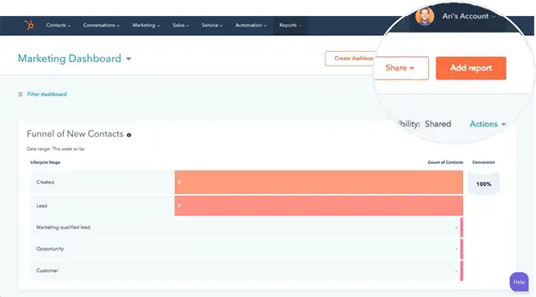
Step Two: Choose Attribution
Click ‘Attribution’. From here, if you're in Professional, you'll see a ‘Contact Attribution’ toggle. In Enterprise you’d see both ‘Contact Attribution’ and ‘Revenue Attribution’.
Step Three: Start with the Templates
One of the things that we love about HubSpot the most, of the many, is that we are prescriptive. So we don't just give you a tool and throw you off into the deep end.
We start with best practices. So all the questions that we get asked from an attribution perspective, we've aggregated those into some templates that you can start with. So you can click between the templates, it makes the report for you as you go. If you like the templates, stick with the templates. If not, you can build something custom as well.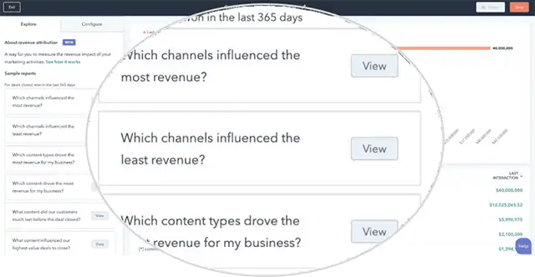
Step Four: Custom Build
Choose your deals, your dimensions, and your model. At the top of that builder, there's an ‘Explore’ tab and a ‘Configure’ tab. Under the ‘Configure’ tab, you have all the different levers you might need, from the type of chart that you're looking at to the deals.
So maybe you just want to look at the deals that were closed in the last month to attribute or maybe it's the deals that are in a certain industry or a certain persona or of a certain size. You could cut that down here. The final piece here is dimension. So we looked at that example from A3C at the source: organic, etc. You could also cut that by the type of content: blog posts vs landing page vs website page. You could cut that by the deal pipeline to any number of dimensions that you can cut that by. Then finally a model: so we looked at the first interaction and full path.
There are six or eight models that you can choose from here depending on how you want to assign your credit across the football pitch.
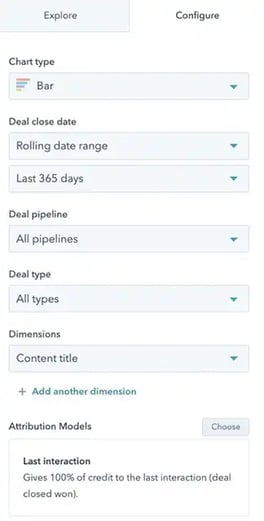
You can either save it to a dashboard or you can save it on its own.
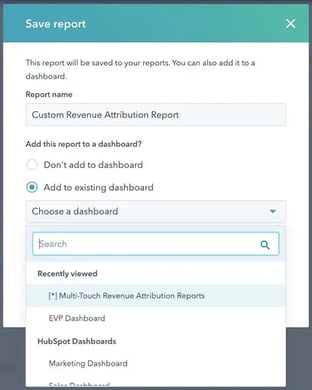
HubSpot Feature Updates
The way that we're thinking about new products and HubSpot this year – you've seen it with this Marketing Hub Enterprise launched in the last few months. We'd like to think about HubSpot as uniquely positioned in the market. There's the easy, and then there's the powerful. Small business solutions often are really easy, but they're not that powerful.
These legacy enterprise systems, mostly CRMs, are really powerful, but they're clunky and complex. HubSpot is the nice balance between those two. It's straightforward to use, but it's also got the power baked in so as you grow, you can run all the business processes that you need.
As we see the new features, this is the way that we're thinking about the paradigm we're using to think about the feature launches this year.
Partitioning: Partitioning is a Marketing Hub Enterprise feature that’s in beta right now. The essential idea is if you have a big company, you have different teams in different regions, you have different business units. You can separate assets between teams.
This is a security feature and a convenience feature. Inside, it’s an internal-facing feature. It doesn't affect the customers at all, but it makes it a lot easier to run a team and keep the team organised inside HubSpot. You can do that for essentially all of the different features inside HubSpot. You can separate pages. You can separate workflows by team. You can separate emails by team.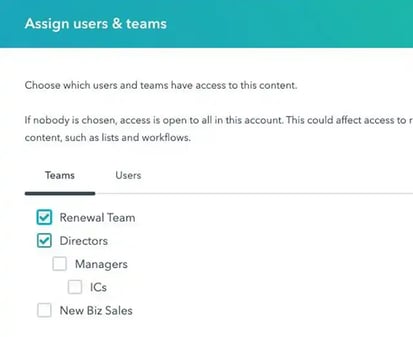
One other feature to mention here as a part of partitioning, we're also rolling out a high-demand feature, where you can separate email preference pages. Up until now, you've only been able to have one set of email subscriptions. If somebody within an email clicks on the email to set their preferences, they see every single preference you have. For HubSpot, that means in our emails – the inbound events, the HUG events, and product updates – all those subscriptions are in the same set. You can imagine a world where you want to separate those.
Maybe you have different brands completely – for instance, KFC and Taco Bell under one conglomerate – and you wouldn't want those preference centres to be merged; you’d want them separate. With partitioning, you can do that. If somebody unsubscribes from one brand, or from one team, they don't unsubscribe to the entire portal email. This is a big one, especially for bigger teams inside of HubSpot.
Adaptive Testing: In A/B testing, you have two different variations of a page – one blue, one red, maybe – and you put them up against each other, test them out, and see which one performs better. At the end you go in, you whip out your statistical significance calculator, you Google that every time and you use that to figure out which version is better, and if you can be sure of that, you pick the winner.
That moves forward as the winner and that stays for 100% of the test. Adaptive testing takes that and makes it completely automated. Instead of setting up the test manually and going in with a calculator and picking a winner at the end, adaptive testing picks the winner for you. You don't waste time, you don't waste the effort of picking the winner.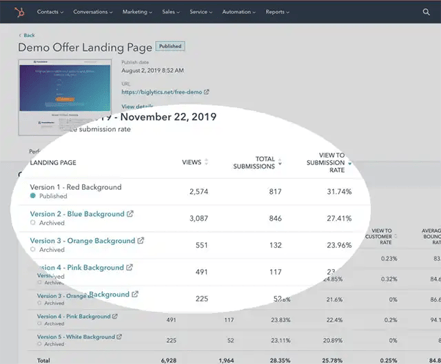
If you think about a traditional A/B test, it gives 50% of the traffic to both variations and that's great, but it means that even if one variation is performing way better, you're still giving 50% of the traffic to the worst performing variation. With adaptive testing, because it uses ML, it continuously optimises that test.
Little by little it gives more and more of the traffic to the better-performing page until finally it picks the winner. It saves your time because it takes out the manual part and it also saves you conversions because it optimises as you go instead of splitting the traffic 50/50 the whole time. It's live to everybody in Marketing Hub Enterprise. If you just want to run standard A/B tests, that's in Marketing or Professional as well and you can run that there.
Account-based Marketing: We've heard a lot about this in the United States and Europe as we've explored it as well. If you're B2B sell into big businesses, you have big, large deals coming in. The deal size is really big. Chances are you're running an ABM program whether you even know it or not.
ABM in HubSpot has always been possible, but it hasn't been super obvious. Account-based Marketing is in Professional and Enterprise and it's actually across all the hubs and sales and service hubs as well. Account-based Marketing has been possible in HubSpot but it hasn't always been easy. It's just a lot easier now.
So one big feature there is company scoring – a company-level scoring.
You've always been able to score leads but you haven't always been able to score companies on accounts, so if you're doing business with companies, you must qualify them too. That's an awesome new feature that's available in professional and enterprise as well.
Advanced Conversational Marketing: You have conversations. You can set up a live chat widget on your website that's in the free version of HubSpot. In the free version up through Enterprise, you can set up a live chat, set up Facebook Messenger, and have a really good conversational experience on the website. What's new in the Enterprise version specifically is really deep targeting for those conversational widgets. You can target based on the examples we have here on a segmented list.
That could be folks from a certain place or folks on a certain persona, who would see a certain chat widget, based on their device type (smartphone, a desktop, iPad, etc.), or session count (e.g. if they'd been to the website before and you want to show them a completely different chat as a repeat visitor, you can do that). Live chat is available to everybody in HubSpot.
You get various levels of functionality as you go up in the tiers, but this is the newest piece that's just an enterprise version, which is the super sick targeting.
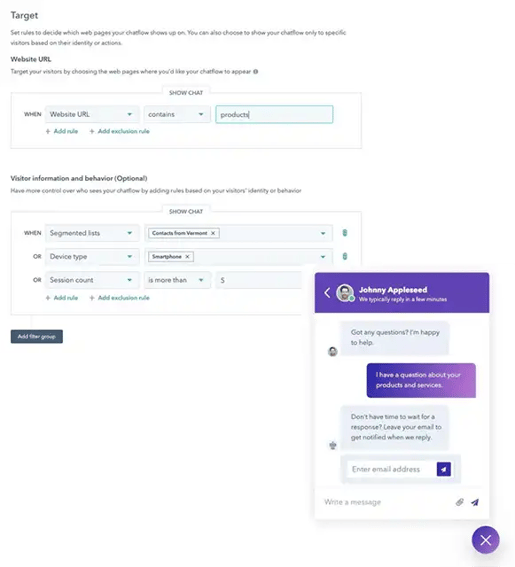
PieSync: We bought this company last year. A big question that comes up is: does HubSpot sync with feature X? The answer is often yes but when it’s not, PieSync, which is now built into HubSpot, allows you to sync 200 additional apps.
The examples you see here are all the different apps that you can sync. The set-up here is super slick. You just have out-of-the-box field mappings and you can add your custom field mappings as you go. If you've ever seen HubSpot with Salesforce or any other system, it looks familiar with PieSync. Because it's available as an add-on, it starts at nine bucks a month and HubSpot users get a discount on that so it’s down to seven bucks a month.
No requirement that you use it, but it's an awesome feature if you're looking to set up syncs with other tools that are in your stack.

Drag and Drop Email Editing: If you create emails in HubSpot, you can drag and drop your templates and your modules into place. That’s emails down to free, so you can edit your emails down to free. We brought that same awesome drag-and-drop editor into pages. So if you're a Marketing Hub Starter or above, you can drag and drop modules into your pages.
Super slick, super easy, and no code is required. You don't have to go into the design manager or get a developer to edit a template or anything like that.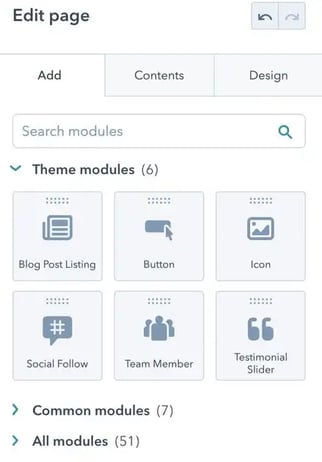
Canva Button: Live to all accounts, not just Enterprise. It's down to free. Canva button. The camera button brings the Canva photo editing, and image editing interface directly inside of HubSpot. When you're creating an email or landing page, you can click on a button that says ‘Edit with Canva’. You go to ‘Add an Image’, click that button, edit with Canva, and then the Canva interface pops up over HubSpot.
So you often to your Canva account, you create your button or whatever it is, you insert it into HubSpot and it brings you right back into the same place you left off. If you're doing photo editing and you find yourself in Photoshop or InDesign a lot, try the Canva Button. Canva is a third-party resource. It's free. So give it a try.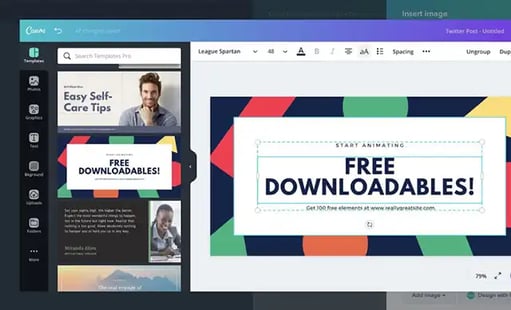
Workflow Updates: Workflows is automation in HubSpot that's in Pro and Enterprise and it's across all the hubs. With workflows, you can now merge branches.
Oftentimes, you have a branching logic to take different contacts or deals down different paths and you end up in a place where all the paths converge, where everybody after a certain point gets the same set of emails, for example, but in HubSpot, you always had to separate the paths and create those same paths again and again on each of those distinct branches.
Now we have a feature, it’s an action in workflows called the ‘Go to’ action, which allows you from one branch to go to another branch. Instead of recreating that same branch over and over again, you can just merge the branch and get everybody back onto the same path later on.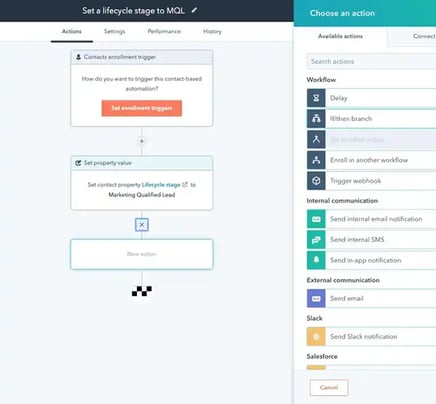
Other things here: copying contact properties to other objects. This was a big ask just in terms of data management. One example here is, you have a contact going through and maybe you want everybody who fills out the demo form. You want a deal to get created and assigned to a sales rep, but you want that deal to have a bunch of information from the form submission – the size of the company, the name of the company, the person's first name and last name, whatever it is.
You can now copy those from a contact record onto a deal through workflows. That kind of cross-object automation has been a really big win for our customers so far.
A few others here: combine conditions, and create folders. Subfolders could question a follow-up with the team and get you an answer on that. I think folders were the big first step and then sub-folders from there. View revisions are a big one, even just in the last couple of weeks.
We're used to using Google Docs, and Google Sheets, where you can just see what version was live when a certain thing happened. The big question with workflows is often: why did somebody not get a certain thing? Being able to view revisions, you can see what you know on a certain timestamp, what a workflow looked like and who updated it last. That’s helpful, especially for the person who runs a HubSpot account or the admin or the ops user.
Forecasting Property: You can do deal forecasting in HubSpot and all HubSpot subscriptions down to free. The forecast has always been a little bit confusing because the forecast and HubSpot pull from deals. You have your deal stages and the deal stages have a percentage to close. You might have a demo stage for deals that's 60% to close or 40% to close.
The forecast that we run in HubSpot, and the default forecasting model and report, multiply that percent by the value of the deal, add that all up and put it into the forecast widget.
Even just explaining it, it's a little bit confusing, so a lot of folks have asked for something that's a little bit easier to approach for sales reps and we now have that. This new forecasting property is a default property in all HubSpot accounts now called Manual Forecast Category.
Instead of using percentages and tying to deal stages, it makes its sales forecast based on the perspective of the rep. They can say what's their best case for a certain deal, most likely they're going to close that deal, they'll commit to closing that deal or the deal is already closed vs using the deal stages. For folks who are doing sales forecasting, this is probably familiar and gives you flexibility. It's not required that you use this, but just so you all know, it's available.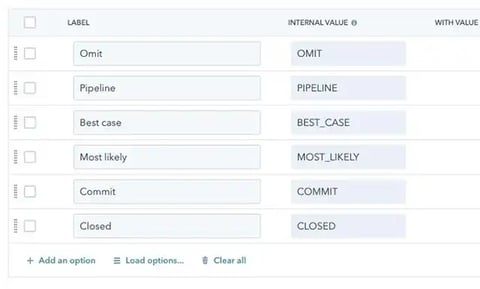
Form Analytics: This is mainly about being able to export and manipulate form data (e.g. who's filled out a form over time, be able to choose multiple forms and see a report that stacks them on top of each other). That's been needed and now it's available. That's in Professional and Enterprise.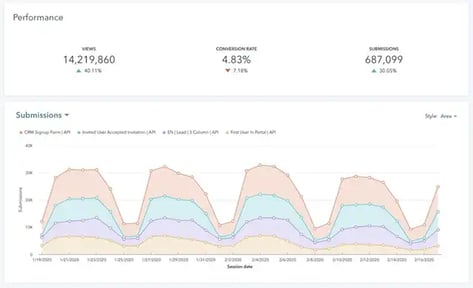
Social Posts Boosting: This is in Professional and an Enterprise. The idea is you can publish all your social through HubSpot. You can also now boost posts. If you're familiar with Facebook Ads, there are different types of ads.
One is you go through the ad manager, you create ads from scratch and all that. The other is you do what's called boosting where you just take something that's that you've already posted to your company feed, and you give that a boost – for instance, to two different audiences.
Straightforward: you pick an audience, you pick a timeline, you pick a budget, and now you can do that all from HubSpot.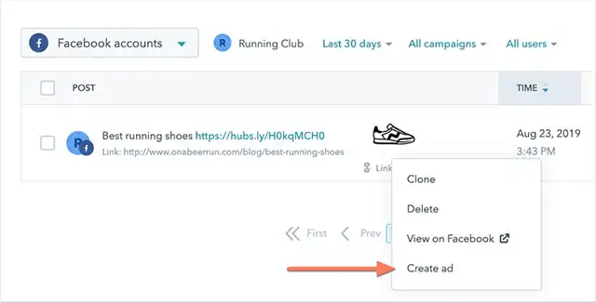
Password-protected Knowledge Articles: Don’t forget we have marketing, we have sales, and we also have a service hub. It starts at free and goes all the way up through Enterprise as well.
One of the Enterprise features is that you can make the knowledge base. If you want a help documentation centre for folks to visit and find out more about a certain thing in your product or your services, you can create that and now you can password-protect those.
If you have a certain knowledge base article that you only want a tiny subset of your audience to be able to see, you can protect that by a specific password or you can just protect that by a certain smart list in HubSpot so only folks on that list will be able to access that knowledge base article.
It’s super slick, the way that the list functionality from the marketing tool that we're all used to plays in and connects that flywheel into the service hub and the service use case as well.




